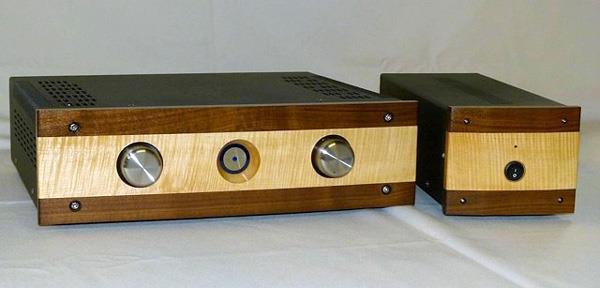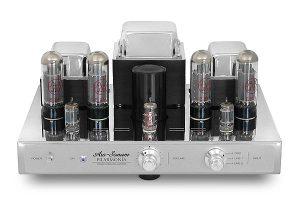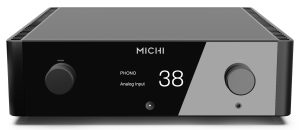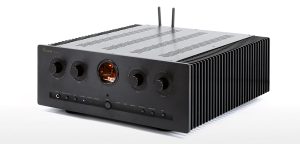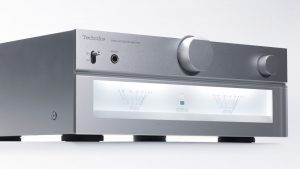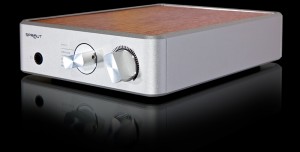Gilbert Yeung, the owner and proprietor of Blue Circle, is an engineer and an artist. He is one of the most brilliant audio designers working today. But he could not care less about marketing. He does not advertise very much and does not openly solicit product reviews, preferring to keep the scale of his operations small. He does not give his products names like the Lionheart, the Conqueror, or the Total Triumph (names I just made up, but which may well exist in the over-heated audiophile market). And his product line is a sprawling assortment of stuff—amplifiers (pre-, power, integrated, and phono), DACs, power conditioning products, cables, and other accessories—that he dreams up and gives numerical, sometimes code-like names (the FtTH2, the BC3 PLS, etc.).
Take a quick tour of the Blue Circle website, and it is not always easy to distinguish the differences between the four power amps, six preamps, or four integrated amps the company currently offers, nor why one may cost a lot more than another. Inside the case, each model is distinct, and each has its own design goal and sonic signature. But on the outside, many look roughly alike.
All of this is definitely not good marketing. But Gilbert is unconcerned. He is plenty busy, serving a die-hard following of Blue Circle enthusiasts and filling a six-month backlog of orders (this is not assembly line work; Yeung makes most everything by hand, to order). The rest of his time is spent doing what he does best: refining his knowledge and experience to create new designs.
Introducing the O22i
The O22i is Yeung's newest integrated amplifier design. Superficially, it looks very much like the FtTH2 amp, which I reviewed three years ago, and which remains in the Blue Circle line. They are both two-piece "integrated" amps—a bit of an oxymoron, it must be admitted—with the main circuitry residing in a standard-sized (17.25 inches wide, 4.75 inches high, 14.25 inches deep) unit, and a large, heavy power supply housed in a separate, smaller box (5.75 inches wide, and a bit taller and deeper than the main unit).
The O22i has the minimalist feature set of other Blue Circle preamps and integrateds: just two big knobs on the front for input selection and volume. The amp has four line-level inputs, one of them balanced. The volume control, a Shallco attenuator, is the same step-type rotary control as on other models; Yeung feels that standard, smooth-turning potentiometers degrade the sound. The volume jumps between the steps, particularly at the lower end of the dial, are quite pronounced. Those who are very sensitive about dialing in their personal "just right" volume may find this frustrating. I do most of my listening at night and at times found it a little frustrating myself.
Fortunately, there are two potential remedies available. Blue Circle makes available, for about a $500 upcharge, a deluxe Shallco with significantly more steps (47 versus the standard attenuator's 31). I haven't heard it, but I'm quite sure the extra steps would address my issue more than sufficiently.
The second remedy is a stock feature of the amp and so costs nothing. That's the one I tried. If you open the top cover of the O22i (or the FtTH, for that matter), the back of the Shallco has a little toggle switch. When the switch is in the up position, its standard setting, the amp is set for high gain. At this setting, the O22i's output capabilities are prodigious. I did much of my listening with the volume knob in the 9 o'clock or 10 o'clock position—meaning that two-thirds or more of the dial was going largely unused.
The down position of that internal switch is the low gain setting. It reduces the amount of available gain, but the volume differences between the steps on the dial are smaller. In this setting, I did most of my listening between 12 and 1 o'clock on the dial—so the range of available gain was focused right in the sweet spot of where I wanted it, and I had no trouble at all finding that "just right" volume. In my room and my system, the low gain setting was a wholly satisfactory solution. If you want more adjustability and need or prefer very high-gain capabilities, the Shallco upgrade is the way to go.
Additional options for the O22i include different faceplates (stainless steel is standard, wood is extra), different knobs (wood is standard, stainless steel extra), and a remote control (for volume only). The review sample had the very deluxe-looking wood fronting, but the standard stainless steel looks smart in a more utilitarian way.
If you really want to jack up the price, you may also add Blue Circle's KQ box to further refine the amp's power-filtering capabilities. This will add another $2,300 or so to the $7,500 base price of the O22i. The KQ made a significant, positive difference with the FtTH2, but I did not audition it with the O22i. Offhand, though, it is hard for me to believe that anything could make the O22i quieter and purer-sounding than it already is. (Yes, I'm getting a little ahead of myself.)
The most obvious internal difference between the FtTH2 and the new O22i is that the former is a tube and solid-state hybrid design, with two 6922 tubes in the preamp stage, while the O22i is all solid-state. The O22i puts out 125 watts per channel into 8 ohms, which is 25 watts more than the FtTH2.
Whatever superficial similarities they may share, the O22i is by no means just a tweaked FtTH2. It sounds to me more like an exciting breakthrough product for Yeung—identifiably a Blue Circle, but very much its own thing.
Listening and Observations
I've listened to a lot of amps over the past 20 or so years. I've auditioned integrated amps and separates, tubes and solid-state, low-powered and high-powered. I've heard a few I liked a lot, and several I respected but had no great enthusiasm for. But in almost every case I can recall, I've been able to discern the designer's editorial hand at work. In other words, I can hear the calculation: rounding off the treble for a warm, "full-bodied" sound, or making the bottom end a little lean to increase perceived detail; going for a fast or a slow sound, an analytical or a musical one.
Blue Circle amps are different. There's something uncanny about them. They just have a natural organic purity. I don't hear the sound being shaped or manipulated. They don't all sound exactly the same, but they all share the same essential sense of musical rightness.
My impression is that Yeung sees each of his designs, first and foremost, as a technical challenge. He plays around with different OEM parts, weighing the particular strengths of each. He is not wedded to a particular design philosophy and basically tries everything: tubes, solid-state, single-ended, class A, class A/B, separates, integrateds, etc. He is obsessed with power delivery and power isolation. The sonic results of each design are a product of their specific approach and Gilbert's technical brilliance, rather than of being actively "voiced" to sound a specific way.
Until now, the FtTH2 was the best amplifier I'd heard in my system. If you have one, you still have a fantastic amp. But the O22i is, to my ears, a clear improvement. The new amp has all of the virtues of the older design: it is sweet and musical, but also fleet and dynamic—in this case, "sweet" is not a euphemism for "dull." It has incredible drive, with seemingly limitless reserves of power. Certainly, it was unfazed by anything I threw at it during the two months or so I had it.
While it is something I have long suspected, the O22i has definitively pushed me toward the belief that watts-per-channel ratings are, at best, rough indicators. Sure, a 20-wpc tube amp may not be capable of driving a big pair of floorstanding speakers. But once you have a sufficient number of watts for a particular pair of speakers there is, in my observation, very little correlation between rated power and actual perceived power. It's about the quality more than the quantity.
The O22i actually claims fewer watts than my reference, the Coda Unison integrated, which has been my off-and-on reference amp for more than a decade. The Unison has been a trooper for me and remains a super-solid performer: clean and relatively neutral, with a pleasing tonal balance that is distinctively solid state but not at all strident. While rated at 150 watts per channel versus the O22i's 125, the latter's sound is altogether bigger, more impactful and enveloping. Crank it up a bit, and you can feel it in your body. Like the other Blue Circle amps I've auditioned, it will play as loud as I need and way beyond with no audible distortion and without the slightest sense of strain, even through my fairly demanding Reynaud Orfeo floorstanding speakers.
More importantly, the musical balance that Yeung has achieved with this new design is near-miraculous. It is, without question, the most beautiful sound I've heard in my home. Despite being all solid-state versus the FtTH2 with its tubed preamp stage (the name stands for "For the Tube Head"), I find the O22i even sweeter, even easier on the ears. The FtTH2 has the midrange presence and golden glow one associates with tube sound, though not an excess of it, while largely avoiding the potentially negative aspects of tube designs (somewhat soft bass, muted large-scale dynamics, and a hooded top end). The O22i, as one would expect, has a more open and extended top end, but that additional treble is so beautifully integrated into the overall picture, and the top to bottom balance so refined, no one would ever call it bright.
But it is by no means artificially sweet. It is a natural, musical sweetness. Plus, the noise floor is so low, and the background silence so deep and so black (the FtTH2 is quiet, too, but inevitably has a little bit of tube rush), the total effect is pretty breathtaking. For me, it leaves nothing to be desired.
Match the O22i with a great recording and jaws will drop. In the ‘70s, Philips released a series of LPs with Neville Marriner conducting the Academy of St. Martin-in-the-Fields in the Rossini overtures. Some of the overtures were recorded (but not released, I don't think) in quadraphonic sound. In 2003, the Pentatone label took the quad recordings and mastered them in both two-channel and four-channel for SACD. The SACD is absolutely one of the best-sounding discs I own. Playing it (in two-channel) through the Blue Circle amp was simply stunning. Every section and instrument of the orchestra was portrayed with crystal clarity. Dynamic shifts, both small-scale and large-scale, were rendered with absolute precision. The speakers disappeared as point sources. The sound was big, intense, and totally transparent.
This transparency, of course, also proved felicitous with more problematic recordings. I am a big fan of the classical pianist Paul Lewis, but not a big fan of the overly reverberant recording style that Harmonia Mundi has given him on his most recent CDs. (Sadly, this is par for the course with solo piano recordings these days, which for my taste tend to have a shallow, boomy, overly "wet" acoustic.) Listening to Lewis' new-ish recordings of Schubert sonatas, the O22i really helped clarify the nuances of his playing, cleanly rendering countless details that were smeared through my reference amp. The reverb was there, to be sure, but the O22i's superior resolution helped clear the fog considerably.
It's an audio reviewing cliché to say this, but the O22i encouraged long listening sessions that made we want to pull out album after album to hear each one anew. I have a lot of CDs from the "Original Jazz Classics" series that Fantasy oversaw for many years in the ‘80s and ‘90s. These reissues of great jazz sessions from the ‘50s and ‘60s are among the most neutral-mastered CDs you can buy—in most cases, the mastering engineers transferred them straight from the original tapes without adding any equalization, limiting or compression whatsoever.
Some find the OJCs just a little soft and thin compared to the louder, hotter-mastered CDs they're used to hearing from other labels. But the O22i would have none of that. It played back these CDs with power and oomph, while retaining the warmth and glow of the original recordings. The sound was live, immediate, and incredibly dynamic. Over the course of a week or so, I returned to old favorites like Art Pepper (Intensity), Hampton Hawes (The Green Leaves of Summer), and Johnny Griffin (The Kerry Dancers and Other Swinging Folk). Sheer beauty.
Of course, I also spent a good deal of time auditioning the Blue Circle amp with vinyl. Here, the O22i had to work its magic with the assistance of an intermediary: my Graham Slee Reflex Phono Preamp. With a circa $1200 retail, the Reflex lives at the lower end of the market compared with the O22i and most of my other components. But it is an impressive little box: very tidy and detailed, with excellent stereo separation and a supple, slightly dark, tonality.
Teaming with the O22i, the Reflex retained its essential character, but the O22i helped it be its best self, bringing the same improvements—in terms of transparency, scale, dynamics, and extension at both the top and bottom ends—to my vinyl listening that it did to my CD listening. Spinning a few of the Analogue Productions reissues from the old RCA Living Stereo catalog (Charles Munch conducting Debussy and Saint-Saens, and Fritz Reiner conducting Bartok and Respighi), I was floored. These oft-reissued recordings have never sounded more stunning, and that's a compliment to both the Analogue Productions platters and the Blue Circle's way with them.
That said, though, a funny thing happened during my time with the O22i. I've always been a vinyl guy at heart. The Rossini/Marriner SACD, mentioned above, is one of the rare instances where I feel a digital version of a particular performance exceeds the analog version. I love the particular strengths of analog sound—the senses of air, depth, presence and, yes, warmth—and find many CDs cold and sterile in comparison.
The O22i did not turn my audio worldview on its head, but it certainly challenged it. For the first time, I began hearing analog and digital as separate but more or less equal. The O22i gave CDs more depth and warmth and dimensionality than I've ever heard through the format, which allowed me to appreciate digital's specific advantages—the perfectly steady pitch, the lack of groove distortion—all the more. I don't like my vinyl any less than I did before, but I like my CDs a lot more.
This is notable, because most of my system—the Reynaud Orfeo speakers, the Bel Canto PL-2 universal player, the VPI Classic turntable, and the Audience adeptResponse power conditioner—has been in place for several years now. Amplification is the variable I have played around with the most, and in recent years I have owned or auditioned a number of integrated amps: the Coda Unison, the excellent all-tube designs from Ayon, the Spirit and the Orion, as well as both versions of Blue Circle's FtTH. So it hasn't been a combination of variables leading to dramatically better digital sound. The O22i, by itself, effected an enormous improvement. It was an eye-opening experience.
… And in closing
I've said this before in reviews, but it bears repeating here: When I read other writers' equipment reviews, I pay attention to the tone of what they say as much as I do to the actual content. We all use the same vocabulary to describe sound, and most products that reach market these days are competent or better than that. With so many products and companies courting such a small audience of audiophiles, there aren't that many bad products out there. The weak simply do not survive.
But at the same time, it is not hard to tell the difference between when a reviewer is offering sincere but somewhat perfunctory praise and when he is thrilled with a particular component. I know as a reader, my eyes begin to glaze over reviews that use all the usual words of praise, but don't seem to have any passion behind them.
I hope I have conveyed such passion re: the Blue Circle O22i. It is for me a thrilling product, one that brought my listening enjoyment to an entirely new level. And it may not surprise you to hear that shortly after auditioning it, my name was added to Gilbert Yeung's months-long backlog of orders. After hearing the O22i, there was no going back to anything else.
Blue Circle O22i integrated amplifier
Retail: $7500 (remote control and deluxe casework are optional)




